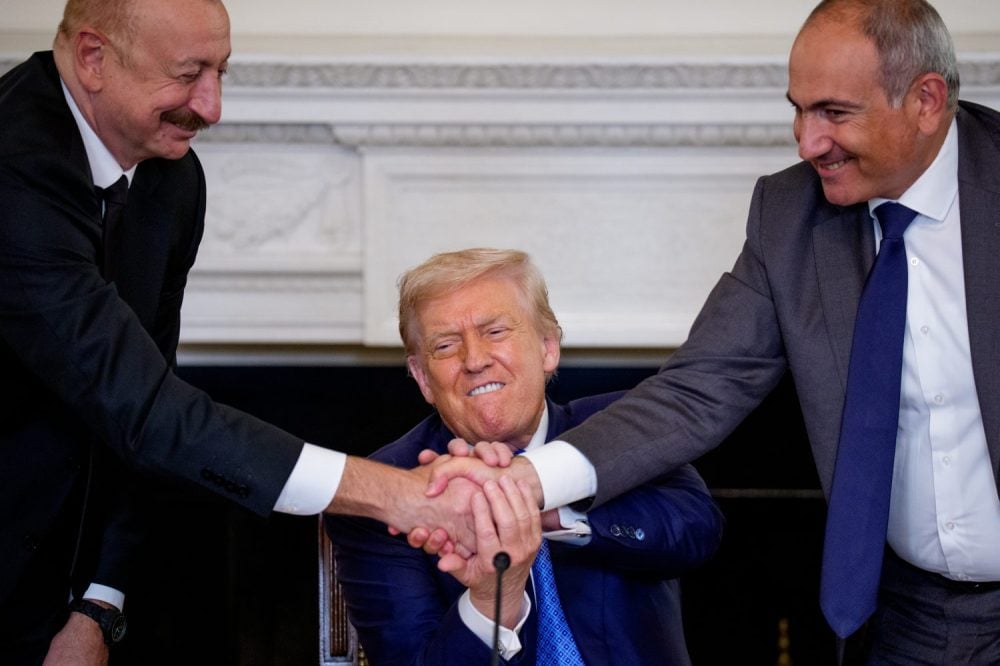The Aug. 8 meeting in Washington between Armenian Prime Minister Nikol Pashinyan and Azerbaijani President Ilham Aliyev marked a watershed in the decades-long struggle between the South Caucasus neighbors. The two countries signed a framework agreement that could lead to the end of a conflict that predates their independence from the Soviet Union, unlock regional trade and investment deals, and insert the United States as an important actor into a region long dominated by Russia, Turkey, and Iran.
Months in the making, the preliminary deal represents one of Washington’s biggest forays into the post-Soviet sphere. Its signing complicates the popular narrative that the Trump administration seeks to pull the United States back from international commitments or cede a sphere of influence to the Kremlin. At the same time, the deal remains incomplete and holds real risks—both for the region and the United States.
The framework agreement suggests that both sides recognize that the time is ripe to seek a lasting peace that could not just end the conflict between Baku and Yerevan, but overcome the geographic and political fragmentation that has long bedeviled the South Caucasus. According to an official who is involved in the effort, the Trump administration expects that a final peace treaty can be signed and ratified by the end of 2026. For that ambition to succeed, however, all parties—including the United States—need to follow through on their commitments while addressing some still-unanswered questions.
The conflict between Armenia and Azerbaijan has been an enduring cause of the South Caucasus’ fragmentation and strategic marginalization. It has also enabled Russian domination of the region, as Moscow has sought to block any final resolution since the 1990s, forcing both Baku and Yerevan to look to the Kremlin as a referee and security provider. Russian involvement prevented the conflict from escalating, but it also prevented a lasting resolution that would allow the two countries to take charge of their own futures.
Azerbaijan’s crushing victory in the Second Nagorno-Karabakh War in 2020, followed by its re-conquest of the remaining bits of Armenian-controlled Nagorno-Karabakh in late 2023, created a fundamentally new reality. To his immense credit, Pashinyan understood that overwhelming military defeat, the loss of Nagorno-Karabakh, and the flight of its ethnic Armenian inhabitants created not just the need for peace, but also an opportunity to seek a permanent end to the conflict. While Yerevan was eager for a peace agreement, Baku long seemed hesitant. The Azerbaijani leadership recognized that it held the stronger cards and could press maximalist demands.
Still, the outlines of a peace accord have been clear for some time: mutual recognition of territorial integrity (including Azerbaijan’s control of the former Nagorno-Karabakh), demarcation of borders, renunciation of legal claims, and diplomatic normalization. Baku and Yerevan announced in March that they had agreed on the outlines of a deal on these terms. Now Armenia and Azerbaijan—with American help—have to move beyond the framework agreement to forge a lasting peace treaty.
Still, many key problems remain to be addressed. Two issues that long bedeviled the negotiations were Baku’s demand for a corridor across Armenian territory connecting the main part of Azerbaijan to the Nakhchivan exclave and for changes to the Armenian constitution that would ensure that future Armenian governments accepted the loss of Nagorno-Karabakh. Nationalist mobilization against Armenia also remains an important source of Aliyev’s political legitimation strategy.
The corridor issue was particularly tricky. Neither side wanted Russian forces to secure the transit route, as they were supposed to do under the terms of the 2020 cease-fire. Armenia rejected any outside presence that compromised its sovereignty, while Azerbaijan demanded unimpeded access to Nakhchivan. Azerbaijani threats to seize control of the route and surrounding Armenian territory did not help matters. A key element of Washington’s behind-the-scenes diplomacy was a proposal for the United States to claim exclusive development rights over the corridor.
A full peace between Armenia and Azerbaijan would bring enormous benefits to people in the region—above all by guarding against another war. It would protect Azerbaijan against any revival of the Karabakh problem while securing Armenia from the threat of Azerbaijani aggression to seize the transit route to Nakhchivan. As part of the overall deal, Azerbaijan will gain a closer strategic partnership with the United States that promises investments in energy and infrastructure—including a proposed trans-Caspian fiber-optic cable—and removal of restrictions on defense cooperation that could strengthen the country’s hand against regional rivals Russia and Iran. Armenia will also benefit from closer security cooperation with the United States and the eventual opening of its borders with Azerbaijan and Turkey, which have been closed since the First Nagorno-Karabakh War in the 1990s.
With the opening of borders, Armenia could benefit from integration into regional trade and transit networks that have long bypassed it. Normalization of the Armenia-Turkey relationship could quickly follow, despite tensions with roots dating to the late Ottoman era, notably over the mass murder of Armenians by Ottoman forces during World War I.
Opening borders and facilitating transit would help overcome the South Caucasus’s long-standing fragmentation, making the region more attractive as a link between Europe and Asia. Further benefits would accrue from the ability to expand trade and investment along the so-called Middle Corridor from China through Central Asia and across the Caspian Sea to Europe. Building out the Middle Corridor, which, among other benefits, would diminish Russia’s leverage across post-Soviet Eurasia, has been one of Washington’s long-term objectives.
Despite the clear benefit that a permanent deal would bring for Baku, Yerevan, and the wider region, the path ahead remains fraught. Keeping both Armenia and Azerbaijan on board until a treaty is signed and ratified will require constant tending. Baku could balk if it believes that promised benefits are not forthcoming—for instance, if the envisioned removal of current restrictions on U.S.-Azerbaijan security cooperation run into trouble on Capitol Hill. While Pashinyan’s government is committed to the agreement, political volatility in Armenia—including an alleged coup attempt by opponents of the deal—could cause problems in Yerevan as well.
The framework agreement also leaves several Armenian concerns unaddressed. These include implementing the framework agreement’s provisions on territorial integrity, which will require Azerbaijani forces to pull out of slivers of Armenian territory they still control, a final settlement over the status of Karabakh Armenian refugees, and Baku’s demand for constitutional change. Trust between Armenians and Azerbaijanis is low, the product of three-plus decades of conflict and demonization. The peace process has been very top-down so far; getting bottom-up support from civil society and ordinary people will be a much longer process in both countries.
Another challenge stems from Washington’s decision to insert itself into the region in a larger way. Both Russia and Iran see even a commercial U.S. presence there as unfriendly. Russian strikes on Azerbaijani-owned energy assets in Ukraine following the White House signing ceremony appear to signal the Kremlin’s displeasure. Iran has also served notice that it will not tolerate a U.S. presence in the region.
For now, Russia’s debilitating war in Ukraine has provided the United States and other outsider powers a window of opportunity to change facts on the ground in a region that Moscow still considers its backyard. Local observers remain nervous at the thought that Russia’s aspirations for regional hegemony have not faded and that an increasingly militarized, belligerent Kremlin will seek to settle accounts in the Caucasus (and elsewhere) once its forces are freed from fighting in Ukraine.
Moscow has been involved in a war of words with Baku in recent months following the downing of an Azerbaijan Airlines passenger flight by Russian air defense, which killed 38 people. Meanwhile, Pashinyan’s supporters accuse Moscow of having a hand in plots to topple the Armenian leader. Russia retains other levers in Armenia as well, including a commanding position in the country’s economy, control of critical infrastructure (such as the country’s only nuclear power plant), and networks of influence in the Armenian Apostolic Church.
The White House is hoping that a mix of U.S. business and enhanced security cooperation for both Baku and Yerevan will provide a sufficient deterrent to prevent either Moscow or Tehran from challenging the new dispensation. That gamble may pay off; if not, it remains an open question whether Washington will risk a conflict with Russia or Iran in the Caucasus.
Even with those concerns, the Armenia-Azerbaijan framework agreement is a significant step toward ending one of the region’s bitterest conflicts. Getting to this point required political courage in Baku and Yerevan, as well as persistence and creativity from the United States (and from France, which helped ameliorate Armenian security concerns throughout the process). One way or another, the agreement signifies the start of a new era in the South Caucasus.
The views expressed in this article are those of the author and are not an official policy or position of the National Defense University, the Defense Department, or the U.S. government.
The post With the Armenia-Azerbaijan Deal, It’s a New Era in the Caucasus appeared first on Foreign Policy.




